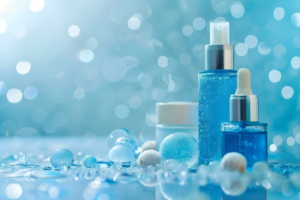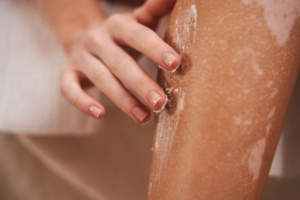Elevate Your Skincare Game with “The Ultimate Dry Skin Routine for Flawless Results.” Achieving flawless skin demands a personalized approach, especially for dry skin types. Dryness can lead to dullness and discomfort, but with the right dry skin routine, you can rejuvenate your complexion. This guide unveils essential steps tailored to nourish and hydrate dry skin, unveiling a radiant glow. From gentle cleansing to targeted treatments, each step is designed to replenish moisture and restore skin health. Say goodbye to dryness and hello to supple, luminous skin with this comprehensive regimen. It’s time to elevate your dry skincare routine and embrace flawless results.
Table of Contents
Definition and Causes of Dry Skin:
Defining Dry Skin
Dry skin, medically known as xerosis, is a common dermatological condition characterized by a lack of moisture and natural oils on the skin’s surface. This deficiency leads to symptoms such as roughness, flakiness, itching, and even cracking of the skin.
Understanding the Causes
Several factors contribute to the development of dry skin such as –
1. Lack of Moisture
When the skin doesn’t retain enough moisture, it can become dry and dehydrated. This can happen due to factors such as low humidity levels, harsh weather conditions (like cold or windy weather), or spending too much time in air-conditioned or heated environments.
2.Age
As people age, their skin tends to produce less oil (sebum), leading to drier skin. Additionally, the skin’s ability to retain moisture diminishes with age, making it more prone to dryness and dehydration.
3. Harsh Soaps and Cleansers
Using harsh soaps, cleansers, or skincare products that strip the skin of its natural oils can disrupt the skin’s moisture barrier, leading to dryness and irritation.
4. Hot Showers or Baths
Prolonged exposure to hot water can strip the skin of its natural oils, leaving it dry and parched. It’s recommended to limit shower or bath time and use lukewarm water instead of hot water to prevent excessive drying of the skin.
5. Underlying Medical Conditions
Certain medical conditions, such as eczema, psoriasis, hypothyroidism, or diabetes, can contribute to dry skin. These conditions can disrupt the skin’s natural moisture balance and impair its ability to retain water, resulting in dryness and flakiness.
6. Genetics
Some people just naturally tend to have dry skin. Their genes can affect how their skin makes oil and holds onto moisture, making them more likely to deal with dryness.
7. Environmental Factors
Exposure to environmental pollutants, harsh chemicals, or allergens can irritate the skin and contribute to dryness. Additionally, factors like UV radiation from the sun can damage the skin’s moisture barrier and accelerate moisture loss, leading to dry, damaged skin.
Dry Skincare Steps
Addressing dry skin involves identifying and addressing the underlying causes while adopting a skincare routine that focuses on hydration and nourishment to restore moisture balance and promote healthy, glowing skin. Here’s your ultimate guide to conquering dry skin and achieving flawless results:

Step 1: Gentle Cleansing
Start your skincare routine with a gentle cleanser specifically formulated for dry skin. Look for hydrating ingredients like hyaluronic acid, glycerin, or ceramides that help retain moisture without stripping away natural oils. Massage the cleanser onto damp skin using circular motions, then rinse thoroughly with lukewarm water to avoid further dehydration.
Step 2: Exfoliation (Optional)
Exfoliation is key to sloughing off dead skin cells and promoting cell turnover, but it’s crucial to choose a gentle exfoliant suitable for dry skin. Opt for chemical exfoliants containing ingredients like lactic acid or fruit enzymes, which effectively remove buildup without irritating. Limit exfoliation to 2-3 times a week to prevent over-drying.
Step 3: Hydration Boost with a Hyaluronic Acid Serum
Hyaluronic acid is like a superhero for dry skin – it can pull in and hold onto moisture really well. Just put a hyaluronic acid serum on your clean, damp skin to rehydrate and plump it up. Let the serum soak in completely before moving on.
Step 4: Nourishing Moisturizer
Choose a rich, emollient moisturizer formulated specifically for your dry skin routine. Look for ingredients like shea butter, squalane, or avocado oil to provide intense hydration and lock in moisture. Massage the moisturizer gently onto your face and neck using upward strokes, focusing on areas prone to dryness. Don’t forget to extend the application to your décolletage for comprehensive hydration.
Step 5: Targeted Treatment (Optional)
If you have specific skincare concerns such as fine lines, redness, or uneven texture, incorporate a targeted treatment into your dry skin routine. Look for products containing ingredients like vitamin C, niacinamide, or peptides to address your skin’s unique needs. Apply the treatment to cleansed skin before moisturizing for maximum efficacy.
Step 6: Eye Cream
The delicate skin around the eyes requires extra care, especially for those with dry skin. Choose a hydrating eye cream enriched with ingredients like hyaluronic acid or vitamin E to combat dryness, fine lines, and puffiness. Gently pat the eye cream onto the orbital bone using your ring finger, avoiding direct contact with the eyes.
Step 7: Sun Protection
Never skip sunscreen, even on cloudy days or indoors. Opt for a broad-spectrum SPF 30 or higher to shield your skin from harmful UV rays and prevent premature aging and sun damage. Choose a sunscreen with moisturizing properties to provide an additional layer of hydration while protecting your skin.
Each of these steps is crucial for rejuvenating dry skin. If you want to tailor a dry skincare routine under budget, visit my blog on “Affordable Skincare Routine: Transform Your Skin Without Emptying Your Wallet 103.“
Choosing the Right Products for Your Dry Skin Routine
When it comes to selecting skincare products for dry skin routine, it’s crucial to opt for gentle yet effective formulations that provide optimal hydration and nourishment. Here’s a guide to help you navigate through the myriad of options and choose the best products for your dry skin routine:

Ingredients to Look For
- Hyaluronic Acid: This powerhouse ingredient is a humectant that attracts moisture to the skin, helping to plump and hydrate dry, parched skin cells.
- Glycerin: Known for its moisturizing properties, glycerin works by drawing water from the air into the skin, keeping it soft, smooth, and supple.
- Ceramides: Those fatty ceramide molecules are super important for keeping your skin’s protective barrier in tip-top shape, stopping it from drying out, and guarding it against nasty stuff in the environment.
- Shea Butter: Renowned for its emollient properties, shea butter deeply moisturizes and nourishes the skin, leaving it feeling velvety soft, and hydrated.
- Occlusives: Ingredients like petrolatum and dimethicone form a protective barrier on the skin’s surface, sealing in moisture and preventing transepidermal water loss.
- Antioxidants: Vitamin E, green tea extract, and niacinamide are potent antioxidants that help neutralize free radicals, protect against oxidative stress, and promote skin repair and renewal.
Avoiding Harsh Chemicals
- Fragrances: Fragrances can be aggravating for dry, sensitive skin, potentially leading to inflammation and worsening existing skin conditions. To minimize irritation, opt for fragrance-free or hypoallergenic products.
- Alcohol: Alcohol-based skincare items can strip the skin of its natural oils, further exacerbating dryness and causing irritation. Maintain your skin’s moisture balance by choosing alcohol-free formulations.
- Sulfates: Sulfates, such as sodium lauryl sulfate and sodium laureth sulfate, are harsh detergents commonly found in cleansers and shampoos. These ingredients can be drying and irritating to the skin, so use sulfate-free alternatives for a gentler cleanse.
- Parabens: While parabens are commonly used as preservatives in skincare products to extend their shelf life, some studies have indicated that they may potentially disrupt hormone function and cause adverse effects on the skin. For your peace of mind and well-being, it is recommended to opt for paraben-free formulations instead.
- Artificial Colors: Synthetic dyes and colorants added to skin care products can cause allergic reactions and skin sensitivities, especially in individuals with dry, sensitive skin. Choose products that are free from artificial colors to minimize the risk of irritation.
Exfoliation Techniques For Dry Skin
For those with dry skin, exfoliation is a vital step in any skincare regimen. By sloughing off dead skin cells and stimulating cell renewal, exfoliation unveils a smoother, more luminous complexion. In this section, we’ll delve into the significance of exfoliation and suggest gentle exfoliating options tailored to the needs of dry skin.

Gentle Exfoliants for Dry Skin
When it comes to exfoliating dry skin, it’s essential to choose gentle exfoliants that won’t strip away natural oils or cause irritation. Here are some gentle exfoliation techniques and products suitable for dry skin:
1. Chemical Exfoliants
- Alpha hydroxy acids (AHAs): These water-soluble acids, such as glycolic acid and lactic acid, gently dissolve dead skin cells to reveal smoother, brighter skin. Look for mild AHA-based exfoliating toners or serums formulated for dry or sensitive skin.
- Beta hydroxy acid (BHA): Salicylic acid, a beta hydroxy acid, is a powerful yet gentle exfoliant that can effectively penetrate deep into the pores to clear out impurities and excess oil. When selecting exfoliating products, opt for those formulated with BHAs, as they can address both dead skin cells and oiliness without causing the skin to become overly dry.
2. Enzyme Exfoliants:
- Papaya and pineapple enzymes: These natural fruit enzymes gently exfoliate the skin by breaking down dead skin cells. Look for enzyme-based exfoliating masks or cleansers designed to brighten and soften dry, dull skin.
3. Physical Exfoliants:
- Jojoba beads or rice bran: Choose physical exfoliants with round, smooth particles to avoid causing micro-tears or irritation. Gently massage the exfoliant onto damp skin in circular motions, then rinse thoroughly with lukewarm water.
4. Exfoliating Tools:
- Soft-bristle brushes or konjac sponges: These gentle tools can enhance the exfoliation process without causing excessive friction or irritation. Use them with a mild cleanser to buff away dead skin cells and reveal smoother, more radiant skin.
Special Considerations for Different Body Parts
When it comes to skincare, one-size-fits-all solutions simply won’t do. Different areas of the body have distinct needs that demand specialized care to preserve their health and vibrancy. In the following section, we’ll explore the unique considerations for nourishing and rejuvenating the face, hands, and feet, ensuring they remain optimally moisturized and nourished.
Face: Protect Your Skin’s Delicate Canvas
The face is often the most exposed part of the body, making it susceptible to environmental damage, sun exposure, and premature aging. To keep your facial skin healthy and radiant, consider the following special considerations:
Sun Protection:
- Protect your skin from the sun’s damaging UV rays by applying a broad-spectrum sunscreen with an SPF of at least 30 every day.
- For optimal protection, be sure to reapply the sunscreen generously every two hours, particularly during extended outdoor activities or water-based pursuits.
Gentle Cleansing:
- Use a mild, non-comedogenic cleanser to remove dirt, oil, and makeup without stripping away natural oils.
- Avoid harsh scrubbing or abrasive exfoliants, as they can irritate sensitive facial skin.
Hydration:
- Choose a hydrating moisturizer suited for your skin type, whether it’s dry, oily, or combination.
- Consider incorporating a facial serum or oil to provide an extra layer of hydration and nourishment.
Hands: Show Your Hands Some TLC
Our hands are constantly exposed to environmental stressors and frequent washing, leading to dryness, roughness, and premature aging. Give your hands the care they deserve with these special considerations:
Moisturize Regularly:
- Remember to moisturize your hands regularly by applying hand cream or lotion, especially after washing or whenever they feel dry. This will help replenish the moisture your hands have lost, keeping them soft and healthy.
- Look for hand creams enriched with ingredients like shea butter, glycerin, or hyaluronic acid for intense hydration.
Protect from the Elements:
- Wear gloves during cold weather to prevent chapping and windburn.
- Apply sunscreen to your hands daily to protect against UV damage and minimize the risk of age spots and wrinkles.
Exfoliate Gently:
- Use a gentle hand scrub once or twice a week to remove dead skin cells and reveal softer, smoother hands.
- Avoid harsh exfoliants that can cause irritation or micro-tears in the delicate skin on your hands.
Feet: Keep Your Feet Happy and Healthy
Our feet often bear the brunt of our daily activities, leading to dryness, calluses, and rough patches. Pamper your feet with these special considerations:
Moisturize Thoroughly:
- Apply a rich foot cream or balm to clean, dry feet, paying special attention to rough areas like heels and soles.
- For extra hydration, wear moisturizing socks overnight to lock in moisture and soften rough skin.
Exfoliate Regularly:
- Use a foot scrub or pumice stone to gently exfoliate rough patches and calluses.
- Incorporate foot masks or peels into your routine to promote cell turnover and reveal smoother, softer feet.
Wear Supportive Footwear:
- Choose shoes that fit well and provide adequate support to prevent friction, blisters, and calluses.
- Rotate your footwear regularly to avoid putting excessive pressure on specific areas of your feet.
Protecting Dry Skin During Winter
As the temperature drops and the air becomes drier, your skin may experience increased dryness, flakiness, and irritation during the winter months. Cold weather can strip your skin of its natural oils, leaving it feeling parched and vulnerable to damage. However, with the right skincare routine and products, you can protect your dry skin and maintain its health and hydration throughout the winter season. In this guide, we’ll discuss essential cold-weather skincare tips and recommend winter-friendly products to keep your dry skin moisturized, nourished, and protected.
Cold Weather Skincare Tips
To combat the effects of cold weather on dry skin, it’s crucial to adjust your skincare routine and incorporate hydrating and protective measures. Here are some cold-weather skincare tips to help you protect your dry skin during the winter:
1. Hydrate Intensively
- Use a rich, emollient moisturizer formulated for dry skin to provide intense hydration and create a protective barrier against harsh weather conditions.
- Apply moisturizer immediately after showering or bathing to lock in moisture and prevent moisture loss throughout the day.
2. Avoid Hot Water
- Limit exposure to hot water, as it can strip your skin of its natural oils and exacerbate dryness. Opt for lukewarm water when showering or washing your face to prevent further dehydration.
3. Protect Your Skin
- Wear protective clothing, such as scarves, gloves, and hats, to shield your skin from cold winds and low temperatures.
- Apply a broad-spectrum sunscreen with an SPF of 30 or higher to exposed areas of skin, as UV rays can still cause damage during winter months.
4. Use Humidifiers
- Use a humidifier in your home to add moisture to the air and prevent dryness, especially if you’re using indoor heating, which can further dehydrate your skin.
Winter-Friendly Skincare Products
Choosing the right skincare products is essential for protecting and nourishing dry skin during the winter season. Look for winter-friendly products enriched with hydrating and soothing ingredients to keep your skin moisturized and comfortable:
1. Hydrating Cleansers
- Opt for gentle, non-foaming cleansers that won’t strip your skin of its natural oils. Look for cleansers containing ingredients like hyaluronic acid, glycerin, or ceramides to hydrate and replenish dry skin.
2. Rich Moisturizers
- Choose moisturizers with a thick, creamy consistency to provide long-lasting hydration and prevent moisture loss. Look for ingredients like shea butter, jojoba oil, or hyaluronic acid to nourish and soothe dry, irritated skin.
3. Hydrating Serums
- Incorporate hydrating serums or facial oils into your skincare routine to boost moisture levels and improve skin elasticity. Look for serums containing ingredients like vitamin E, niacinamide, or rosehip oil to hydrate and repair dry, damaged skin.
4. Overnight Masks
- Treat your dry skin to an overnight mask or sleeping pack to provide intense hydration and nourishment while you sleep. Look for masks containing ingredients like squalane, avocado oil, or ceramides to wake up to soft, supple skin in the morning.
Seeking Professional Help for Dry Skin
While dry skin is a common concern for many people, severe or persistent dryness may require professional intervention to effectively manage and treat. Dermatologists are specialized medical professionals who can diagnose and address a wide range of skin issues, including dry skin. In this guide, we’ll discuss when it’s appropriate to see a dermatologist for dry skin concerns and explore prescription treatments that may be recommended to alleviate dryness and restore moisture to the skin.
When to See a Dermatologist
If you’re struggling with dry skin that doesn’t improve with over-the-counter remedies or lifestyle changes, it may be time to seek the expertise of a dermatologist. Here are some indicators that you should consider scheduling a dermatology appointment for your dry skin:
1. Persistent Dryness
If you’ve been experiencing persistent dryness, flakiness, or itching despite using moisturizers and other skincare products, it’s essential to consult a dermatologist for a comprehensive evaluation.
2. Skin Conditions
If your skin is dry, it could be a sign of a skin condition like eczema, psoriasis, or dermatitis. You should see a dermatologist to figure out what’s causing it and get the right treatment.
3. Worsening Symptoms
If your dry skin symptoms are worsening over time or affecting your quality of life, it’s crucial to seek professional help to prevent further complications and discomfort.
4. Impact on Daily Activities:
Severe dry skin can interfere with daily activities such as bathing, dressing, and sleeping. If your dry skin is significantly impacting your daily life or causing emotional distress, don’t hesitate to reach out to a dermatologist for help.
Prescription Treatments
Dermatologists have access to a variety of prescription treatments that can effectively manage and treat dry skin, especially in cases of moderate to severe dryness or underlying skin conditions. Here are some common prescription treatments for dry skin:
1. Topical Steroids
Prescription-strength corticosteroid creams or ointments can help reduce inflammation and relieve itching associated with dry skin conditions such as eczema and dermatitis.
2. Topical Calcineurin Inhibitors
These medications, such as tacrolimus and pimecrolimus, are often prescribed for eczema and work by suppressing the immune response that contributes to inflammation and dryness.
3. Topical Moisturizers
Dermatologists may recommend prescription-strength moisturizers containing ingredients like urea, lactic acid, or ceramides to replenish moisture and improve the skin’s barrier function.
4. Oral Medications
In some cases, oral medications such as antihistamines or immunosuppressants may be prescribed to manage severe itching, inflammation, or immune-mediated skin conditions.
5. Phototherapy
Phototherapy, or light therapy, involves exposing the skin to specific wavelengths of light to reduce inflammation and promote healing. It can be an effective treatment option for certain types of eczema and psoriasis.
Consistency is key when it comes to skincare routines, especially for dry skin types. By following this comprehensive regimen religiously, you’ll nourish and hydrate your skin from within, unveiling a radiant, flawless complexion. Say goodbye to dryness and hello to supple, luminous skin with the ultimate dry skin routine for flawless results.




